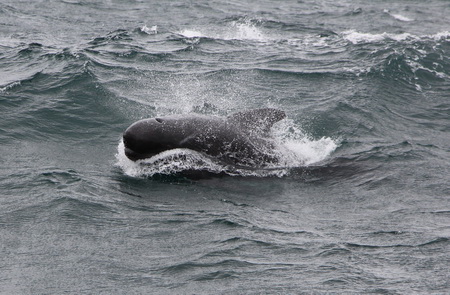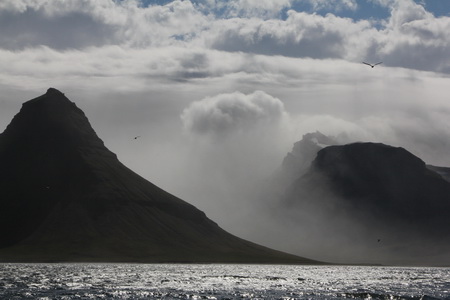The Song of the Whale left Reykjavik harbour on the sunny evening of August the 4th with the crew consisting of Richard McLanaghan (skipper), Mat Jerram (1st mate), Olly Boisseau (senior scientist) and Milaja Bennett (research assistant), and with our visiting scientists Dr. Marianne Rasmussen and Maria Iversen (University of Iceland research centre in Húsavik) and students Luisa Klotz (University of Vienna) and Michelle Allentoft Lange (University of Copenhagen). Marianne supervises Maria’s PhD project on the acoustics, photo-id and abundance of blue whales. Marianne also supervises Luisa’s MSc project on the photo-id of humpback whales in Skjálfandi bay and Michelle’s BSc project on the behaviour of white-beaked dolphins. Everyone was excited to get on the water and looking forward to the next five days at sea!
Throughout the journey we had multiple sightings of harbour porpoises, minke whales, fin whales, pilot whales and white-beaked dolphins despite the almost continuous fog that lingered around our boat. Everyone was hoping to see sperm whales since we kept hearing their echolocation clicks through our towed hydrophones but unfortunately we did not see them in the end.
The main purpose of this leg of the journey was to deploy an “EAR” (=Ecological Acoustic Recorder) in order to record and store any vocalizations from passing baleen whales for Marianne’s and Maria’s research (done in collaboration with Dr. Mark Lammers at the University of Hawaii). Marianne and Maria also want to compare the recordings with previous recordings of blue whales they have from Skjálfandi Bay, to compare whether there are differences in vocalization rates and types between shallow and deep water and also to get an idea of the migration routes of the blue whales. The EAR was deployed on the early morning of the 6th of August at a depth of 310 meters close to Strede Bank, an area north west of Iceland approximately half way to Greenland. This area was chosen because no trawling is done in the area and more importantly a previously tagged blue was recorded in the area in August 2009. EAR is now sampling at 16kHz for 10 minutes every 15 minutes until we recover it on the week commencing on the 10th of September.
On our last day at sea we started seeing a glimpse of our destination, the magnificent high cliffs of Grundarfjörður where we would spend the night. The town was surrounded by waterfalls and beautiful scenery, and our spirits were high even though we had to anchor outside the bay due to strong winds gusting over 50 knots.
Milaja


Sorry, comments are closed for this post.